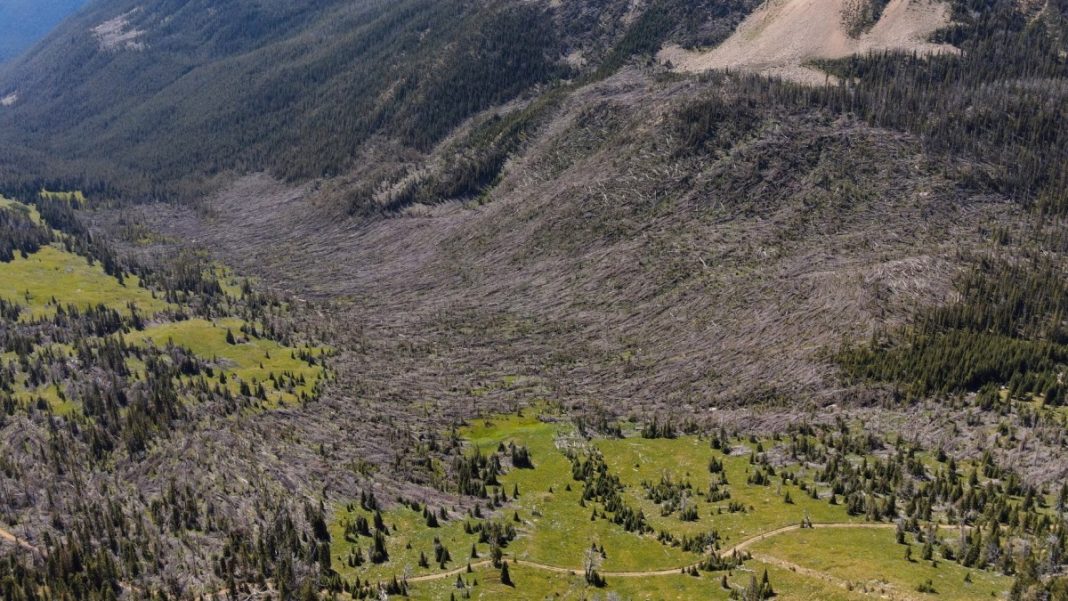A scary experience.
On the afternoon of Sunday, August 11th 2019, a microburst occurred in the Tobacco Root Mountains of southwestern Montana, blowing down the estimated 200 to 250 acres of trees shown in the photo above. This blowdown resulted in the blockage of trails leading back to Granite Lake, stranding 4 people in the backcountry due to trees blocking trails leaving the area. Personnel from the Madison County Search and Rescue and a National Forest Service fire team were sent in to rescue those who were stranded, and two military helicopters were dispatched to see if anyone else was in the area.
Fours years later.
I didn’t plan any big adventures this summer – just wanted to enjoy being home and take some day hikes in the Helena area before heading back to Hays for my final (42nd) year of teaching. One thing I did want to do this summer was hike into the Tobacco Roots, check out the blowdown, take some drone photos, and then use this blog post (#100) to explain microbursts. I left Helena at 6:30 am on 7/14/23, made the 100-mile drive to an ATV trail near Pony, and started walking. As long as I was in the area, I decided to climb Granite Peak as well. Not to be confused with the Granite Peak in the Beartooths (Montana’s highest mountain), this Granite Peak (10,580 ft.) is impressive in its own right – second tallest in the Tobacco Roots, not far behind Hollowtop, which stands 10,604 feet above sea level.
Hiking 9 to 5.
The hike ended up being 15 miles round-trip. All but the final couple hundred yards to the summit of Granite Peak were on a rocky path best-suited for ATVs. I started hiking at 9 am and finished at 5 pm. Despite the poor trail conditions, it was an enjoyable day – the weather was perfect, the blowdown did not disappoint, and views from the summit of Granite were amazing due to exceptionally clear skies. For details about the hike, including maps and photos, check out the photo tour (link below). If you’d like to learn more about microbursts, keep reading.
The sky is falling!
So, why do microbursts happen? Like tornadoes, lightning, hail, and flash floods, microbursts are associated with severe thunderstorms. One of the main causes is evaporative cooling – the same process that happens when sweat evaporates from your skin. As sweat evaporates, it cools your body because the water molecules absorb (and remove) heat when they change from liquid to vapor. The same thing can happen within a thunderstorm. As rain or hail falls through very dry air, or the thunderstorm draws in dry air, much (or all) of the precipitation may evaporate (called sublimation when hail changes to vapor). Water molecules absorb heat from the surrounding air to make this phase change, making the air much colder. The more evaporation, the colder the air gets. Anyone who has opened a refrigerator door knows that colder air is heavier than warmer air. As this air (cooled by the evaporation of rain, or sublimation of hail) gets heavier, it plunges toward the ground like a lead weight. When the microburst reaches the ground surface winds may exceed 150 miles per hour – strong enough to blow fully grown pine trees over. Interestingly, the opposite phase change (vapor to snow) releases heat, contributing to the warming effect that causes Chinook winds.
Mr. Tornado.
Microbursts were discovered in the 1970s by tornado scientist Ted Fujita who developed the famous Fujita scale for rating tornado intensity. No doubt, you’ve heard of an F5 tornado – the ‘F’ stands for Fujita. The scale was revised several years ago – now called the ‘Enhanced Fujita Scale’ (EF0 – EF5). Fujita proposed that microbursts were for real, and suggested they were responsible for a number of mysterious aircraft crashes that had happened in the past during takeoff or landing beneath thunderstorms. Confirmation of his hypothesis ultimately led to a reduction in aircraft accidents and saving of lives.
Icing on the cake.
Seeing the blowdown totally made my day, so I was energized and ready for the second half of my trek. I followed the ATV trail for another 3 miles to a pass, and then scampered up the north slope to the top of Granite Peak. I was pleasantly surprised at how far I could see – even on clear days this summer, it seems that visibility has been somewhat limited. I spent about 45 minutes enjoying the views and taking photos (some with my drone), before starting back. For me, it was a fun outing, but unless seeing the microburst damage is important to you, I recommend climbing Hollowtop instead. Although there is no trail, the extremely steep route I followed up Hollowtop was much more pleasant, and the peak itself is more interesting – plus it’s the tallest one in the range. Check out my blog post for details (link below). Happy trails!
Follow me on Instagram: rodbenson406













